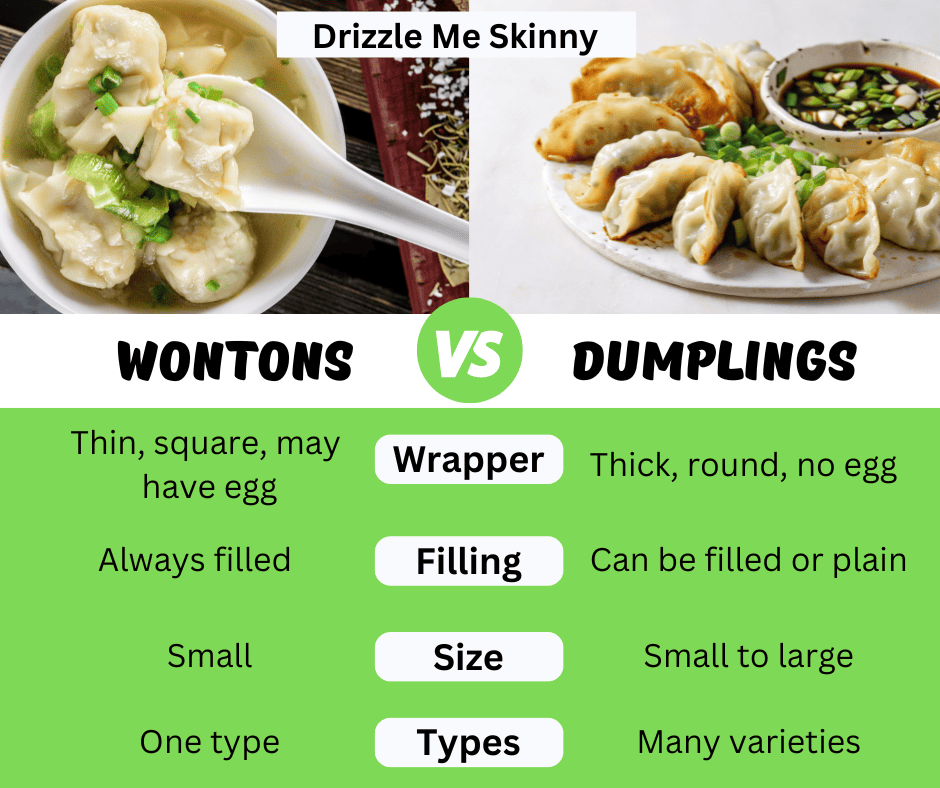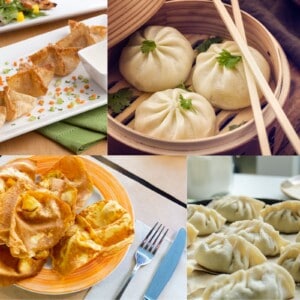Wontons and dumplings are both delicious dough-based dishes that are ubiquitous in Chinese cuisine. They share many similarities, from dough ingredients to the wide variety of filing options for both.
Wontons are in fact a type of dumplings, though not all dumplings are wontons. So what exactly are these flavorful dough pockets? Read on to learn their origins, how they’re made, and what makes them different—and check out our favorite recipes for each!

What are dumplings?
Dumplings are parcels of unleavened dough that may or may not be filled with a variety of sweet or savory ingredients. Many cultures around the world have their own version of these delightful pillows of yumminess, but the Chinese dumpling is arguably the most quintessential of all.
Chinese dumplings are called jiaozi. They range in size and substance and can be served as either an appetizer or a main course. Dumplings can have lightly-favored fillings or be served plain. They are usually accompanied by a dipping sauce.
Origins of dumplings
The first known recipe for dumplings appeared in the Roman recipe text Apicius, compiled in the fifth century AD. These simple boiled dumplings called for a filling of meat, fat, broth, and seasonings. Dumplings like these are still widely popular throughout Europe and Asia.
The Chinese dumpling, or jiaozi, was invented during the Han Dynasty by Zhang Zhongjing. According to legend, Zhang was known as a healer and a medical saint. He created the Chinese dumpling as a way of administering healing herbs.
Upon returning to his village after a harsh winter, his people were suffering from illness and frostbite. He blended together a mixture of cooked lamb, black peppers, and medicinal herbs and cooked them inside a simple dough. Thus, the Chinese dumpling was born.
Shape of dumplings
The most common shape of Chinese dumplings is a half-moon, or crescent, shape. It’s said that Zhang formed his medicinal pockets this way to resemble an ear because his people were suffering frostbite on their ears.
The simplest method for wrapping a dumpling is to place the filling in the middle of a round wrapper, then fold it over and seal it. However, countless ways to fold a dumpling result in many shapes and sizes.
What is a dumpling wrapper made of?
Dumpling dough is a simple mixture of wheat flour, water, and salt. Dumpling wrappers can vary in thickness depending on the type of dumpling being prepared and the cooking method being used. However, they tend to be on the thicker side and may have a crispy or chewy texture.
What are the most common dumpling fillings?
There is no shortage of possibilities when it comes to filling a dumpling. Chinese dumplings can be savory or sweet, or they may contain no filling at all.
Savory dumplings usually contain minced pork and shrimp or a combination of beef, chicken, and lamb. Stir-fried vegetables, such as cabbage, onion, bok choy, and carrots can be added to meat and seafood or used separately to make a vegetarian dumpling.
Sweet dumplings may contain various fruits, cheeses, and even a gooey peanut sauce.
How many types of dumplings are there?
Most cultures across the globe have their own version of a dumpling. They are particularly popular in Asian cuisines, from Korean-style mandu to Japanese gyoza.
In China, there are many variations in both the fillings used and how dumplings are wrapped. Three of the most common dumplings in China are potstickers (pan-fried crescents), dim sum (purse-like “bao” buns), and wontons (see below!)
How to make dumplings
Whatever type of dumpling you’re going for, you’ll follow the same basic steps:
- Prepare the filling ingredients.
- Mix and roll out the dough.
- Add filling to the dough, fold, and seal.
- Cook the dumplings.
- DEVOUR the dumplings!
How are dumplings cooked?
There are three basic methods for cooking dumplings: steaming, boiling, and pan-frying.
What to serve with dumplings
This will depend largely on the type of dumplings you’ve prepared., but as a general rule, dumplings are almost always served with a dipping sauce. This is largely because the fillings (if there are any) are only lightly seasoned.
Smaller dumplings may be served as an appetizer or as an accompaniment to a larger meal. Bigger dumplings, such as bao buns, can be a meal of their own. Dumplings with no filling may also be served in soups and are scooped up with a soup spoon.
Best dumpling recipes
For a traditional Chinese dumpling recipe, head over to The Woks of Life for what they call “The Only Dumpling Recipe You’ll Ever Need!” Straight from grandma’s recipe book to your plate, this crescent dumpling is packed with flavor and the recipe has options for different cooking methods.
If you’re in the mood for some Western-style dumplings, check out our Vegan Chicken and Dumplings soup! This nourishing comfort-food recipe is lighter on the waistline but full of flavor and nutritious ingredients!
What is a wonton?
Wontons are perhaps the most well-known of all Chinese dumplings. But what separates wontons from all the other types of Chinese dumplings? This largely comes down to the filling.
Unlike other jiaozi, wontons always have a filing. This is a main difference between wontons and dumplings. While filling ingredients can vary, wonton filling is well-seasoned and is typically thickened with some type of starch. Because the filling is so rich and flavorful, there’s no need to serve it with dipping sauces.
Wontons make wonderful appetizers and are commonly added to soups and other dishes.
Origins of wontons
“Wàhn tān” is a Cantonese word meaning cloud. Some say this is because it’s like eating a delicate cloud, whereas others say the name comes from its appearance of being a cloud in the sky when served floating in a soup.
Although some say wontons were first mentioned in cookbooks from the Tang Dynasty, most agree they are hundreds of years old—relatively young, compared to many other Chinese foods.
They were originally reserved for upper-class eaters. After World War II, they grew in popularity and became a staple for all classes, often appearing in markets and restaurants.
Shape of wontons
Because the thin dough for wontons is generally square, they are most commonly folded into triangle shapes. Wontons for soup are often folded differently, making little “purses.”
As long as they are sealed properly, you can fold them into any shape that want. Souper Diaries has a great tutorial for folding wontons into different shapes!
Are wonton and dumpling wrappers the same?
In addition to the flour, water, and salt used in jiaozi, many recipes for wonton wrapper dough also call for egg. Another difference between jiaozi and wonton doughs is the water-to-flour ratio. Wonton dough has a higher ratio of flour to water.
Wonton wrappers are thinner than that of most dumplings. This is partially because the filling is thicker and doesn’t need as much dough to hold it in place.
What is traditionally in wonton filling?
As with dumplings, filling options for wontons are endless. The most common filling ingredients include minced pork and shrimp or prawns with a bit of flour used as a binder. Shallot, ginger, garlic, scallions, chili, and bok choy are often added for taste.
While wontons are most often savory, they can also be made sweet with cheeses, fruits, and sauces, such as peanut sauce.
Are there different types of wontons?
While the filing inside a wonton can vary greatly, there aren’t actually different varieties of wontons.
How to make wontons
The steps for making wontons are the same as other dumplings:
- Prepare the filling ingredients.
- Mix and roll out the dough.
- Add filling to the dough, fold, and seal.
- Cook the wontons.
- Enjoy as a side dish or in soup!
One of the most crucial steps in making wontons is sealing them so that the filling doesn’t seep out of the thin wrapper. This is done by wetting the wrapper edges until they’re sticky and then firmly sealing them while squeezing any excess air out.
How are wontons cooked?
Wontons can be boiled, deep-fried, pan-fried, or steamed. Soup wontons can be cooked in the broth they’re served in.
What to serve with wontons
Because wonton filling is generously seasoned, they are often served without the dipping sauces that commonly accompany dumplings. However, duck sauce, plum sauce, soy sauce, oyster sauce, sweet and sour sauce, or hot mustard are great options for fried wontons.
Wontons are generally smaller than dumplings and thus are not considered a main dish. They are often served as appetizers, atop rice dishes, or in a bowl of soup.
Best wonton recipes
New York Times Cooking has a great traditional wonton recipe with shrimp, pork, and aromatic seasonings. This recipe calls for packaged wonton wraps. Head to All Recipes if you prefer making your dough from scratch.
For an unconventional twist on wontons, give our BBQ chicken, bacon, and ranch wonton cups a try!
Summary: What is the difference between a wonton and a dumpling?
Wontons are a type of dumpling, but not all dumplings are wontons! When comparing Chinese dumplings vs wontons, some key differences are:
- Wrappers: Wonton wrappers are thinner, are usually square, and may contain egg. Dumpling wrappers are thicker, are usually round, and don’t require egg.
- Filling: Dumplings can be filled or unfilled. Wontons always have a well-seasoned filling. Filling ingredients for both vary greatly.
- Size: Dumplings range from small (appetizer size) to large (a meal on their own). Wontons are small and are usually served in soups or as an appetizer.
- Varieties: While there are many types of dumplings (wontons being one), there is only one kind of wonton.
Related Recipes
Be sure to check out some of our other trending “VS” articles!
Frequently Asked Questions (FAQs)
Q1: Can wonton wrappers be used for dumplings?
A: While purists may not agree, you can use wonton wrappers for dumplings in a pinch. Because wonton wrappers are square, you may want to round them off before filling.
Q2: Are wontons just dumplings?
A: Yes, wontons are one of many types of Chinese dumplings.
Q3: Is wonton same as potsticker?
A: Wonton and potstickers are two different types of Chinese dumplings. Wonton filling is thicker, while potsticker filling is soft and moist. They use different wrappers and are often folded differently as well.
Q4: Do all dumplings have filling?
A: No. Dumplings can be made plain (just the dough) or with filling. Plain dumplings are typically served with sauce or are eaten with hot pot meals or in soup.
Wonton vs Dumpling: What’s the difference?

Equipment
- New York Times Wonton Recipe
- All Recipes Wontons from Scratch
- BBQ chicken, bacon, and ranch wonton cups
- The Woks of Life Dumpling Recipe
Ingredients
- Choose your favorite recipe
- Click the link to view the recipe.
- Follow instructions at linked recipe
- Enjoy

